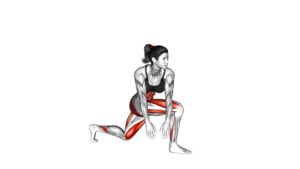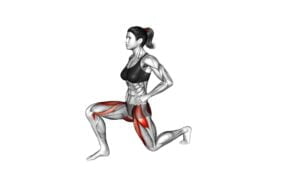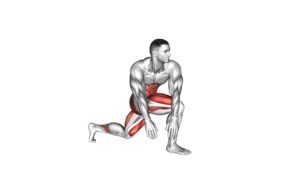Kneeling Hip Flexor (female) – Video Exercise Guide & Tips

Are you looking for a way to strengthen your hip flexors? Look no further!
Watch This Exercise Video
In this video exercise guide, we'll show you the proper form and technique for the kneeling hip flexor exercise. You'll also discover variations and modifications to challenge yourself even more.
Avoid common mistakes and maximize the effectiveness of this exercise with our helpful tips.
Get ready to improve your hip flexor strength and flexibility with our easy-to-follow guide!
Key Takeaways
- The kneeling hip flexor exercise improves hip flexibility and increases range of motion in the hips.
- It strengthens lower body muscles, including the quadriceps, hamstrings, and glutes.
- The exercise specifically targets the hip flexors, which are important for stability and mobility.
- Proper form and technique, such as keeping the front knee directly above the ankle and avoiding arching the lower back, are crucial for maximizing the effectiveness of the exercise.
Benefits of the Kneeling Hip Flexor Exercise
By engaging in the kneeling hip flexor exercise, you can improve your hip flexibility and strengthen your lower body muscles. This exercise specifically targets the hip flexors, which are a group of muscles located in the front of your hips. The primary benefit of the kneeling hip flexor exercise is to increase the range of motion in your hips, allowing for better mobility and flexibility. Additionally, it helps to strengthen the muscles in your lower body, including the quadriceps, hamstrings, and glutes.
One of the key advantages of this exercise is that it can be modified to suit different fitness levels. Beginners can start by simply lunging forward with one leg and holding the position for a few seconds. As you progress, you can increase the intensity by adding weights or using a stability ball. This exercise can also be performed in different variations, such as the kneeling hip flexor stretch, which focuses more on stretching the hip flexors rather than strengthening them.
However, it's important to take precautions when performing the kneeling hip flexor exercise. Make sure to maintain proper form throughout the exercise, keeping your back straight and your core engaged. Avoid excessive forward leaning or arching of the back, as this can put strain on your lower back. If you have any pre-existing hip or knee injuries, it's advisable to consult with a healthcare professional before attempting this exercise.
Proper Form and Technique for the Kneeling Hip Flexor Exercise
To perform the kneeling hip flexor exercise with proper form and technique, focus on maintaining a stable and aligned position throughout the movement.
This exercise is great for targeting and stretching the hip flexors, as well as strengthening them.
Start by kneeling on a mat or soft surface with one leg forward and the other knee on the ground. Your front knee should be directly above your ankle, forming a 90-degree angle. Keep your back straight and engage your core for stability.
To begin the movement, slowly lunge forward by shifting your weight onto your front leg. Keep your upper body tall and avoid leaning forward. You should feel a stretch in the hip flexor of the back leg. Hold this position for a few seconds, then return to the starting position.
It's important to maintain proper form throughout the exercise. Avoid arching your lower back or allowing your front knee to extend beyond your toes. Focus on using your hip muscles to control the movement.
To deepen the stretch, you can raise your arms overhead or slightly lean back. Remember to breathe deeply and exhale as you lunge forward.
Incorporating hip flexor stretches and strengthening exercises like the kneeling hip flexor exercise into your routine can help improve your flexibility and reduce the risk of hip injuries.
Remember to listen to your body and stop if you experience any pain or discomfort.
Variations and Modifications of the Kneeling Hip Flexor Exercise
For variations and modifications of the kneeling hip flexor exercise, you can incorporate different equipment or adjust the range of motion to target specific muscle groups. Here are three alternatives and equipment needed to enhance your workout:
- Weighted Kneeling Hip Flexor: To add resistance and increase the intensity of the exercise, hold a dumbbell or kettlebell in one hand while performing the movement. This will challenge your hip flexor muscles even more and help build strength.
- Kneeling Hip Flexor Stretch: If you want to focus more on stretching and improving flexibility, you can modify the exercise by extending the range of motion. Instead of pushing your hips forward, gently lean your upper body backward, feeling a stretch in your hip flexor muscles.
- Kneeling Hip Flexor with Stability Ball: Incorporating a stability ball can provide an unstable surface, engaging additional stabilizer muscles. Place the stability ball against a wall and lean your hips into it, performing the kneeling hip flexor exercise as usual. This variation adds an extra challenge to your core and balance.
Common Mistakes to Avoid While Performing the Kneeling Hip Flexor Exercise
Avoiding these common mistakes will help you maximize the effectiveness of the kneeling hip flexor exercise and prevent potential injuries.
Proper technique is crucial for getting the most out of this exercise. One common mistake to avoid is allowing your front knee to extend past your toes. This puts excessive stress on the knee joint and can lead to discomfort or injury. To prevent this, make sure to keep your front knee directly above your ankle throughout the movement.
Another mistake is arching your lower back excessively. This not only decreases the effectiveness of the exercise but also puts strain on your lower back. To maintain proper form, engage your core muscles and keep your spine in a neutral position.
Lastly, rushing through the exercise and not maintaining control can lead to poor results. Take your time and focus on the muscles you're targeting. This will ensure that you're activating the hip flexors effectively.
By avoiding these common mistakes and maintaining proper technique, you'll be able to maximize the benefits of the kneeling hip flexor exercise and achieve better results.
Now, let's move on to some tips for maximizing the effectiveness of this exercise.
Tips for Maximizing the Effectiveness of the Kneeling Hip Flexor Exercise
To maximize the effectiveness of the kneeling hip flexor exercise, focus on maintaining proper form and engaging the targeted muscles. Here are three tips to help you maximize your results and get the most out of your hip flexor stretches:
- Stretch both sides evenly: It's important to stretch both the left and right hip flexors to maintain balance and symmetry in your body. By ensuring equal stretching on both sides, you can prevent muscle imbalances and reduce the risk of injury.
- Gradually increase intensity: Start with a gentle stretch and gradually increase the intensity over time. This will allow your muscles to adapt and become more flexible. Push yourself, but listen to your body and avoid overstretching.
- Hold the stretch for an adequate amount of time: To effectively stretch the hip flexors, hold the stretch for at least 20 to 30 seconds. This will give your muscles enough time to relax and lengthen. Remember to breathe deeply and relax into the stretch for maximum benefit.
By following these tips, you can maximize the effectiveness of your kneeling hip flexor exercise and achieve optimal results. Remember to always prioritize proper form and listen to your body to prevent any injuries.
Happy stretching!
Frequently Asked Questions
How Many Sets and Reps Should I Do for the Kneeling Hip Flexor Exercise?
To get the most out of the kneeling hip flexor exercise, it's important to focus on proper form and technique.
Start with a comfortable number of sets and reps, such as 2 sets of 10 reps. As you become more comfortable and experienced, you can progress by increasing the difficulty.
This can be done by adding weights or incorporating variations like lunges or knee drives. Remember to always listen to your body and make adjustments as needed.
Can I Perform the Kneeling Hip Flexor Exercise if I Have Knee Pain?
If you're experiencing knee pain, it's important to modify the kneeling hip flexor exercise. Instead of kneeling directly on the ground, you can use a folded towel or cushion for extra support. This can help alleviate pressure on your knees.
Despite the modification, the kneeling hip flexor exercise still provides benefits such as strengthening the hip flexor muscles, improving hip mobility, and increasing overall lower body stability.
Is It Necessary to Use a Mat or Cushion While Performing the Kneeling Hip Flexor Exercise?
Yes, it's necessary to use a mat or cushion while performing the kneeling hip flexor exercise. This helps to provide support and protect your knees from discomfort or pain.
Using a mat or cushion also allows for proper alignment and stability during the exercise, ensuring that you maintain the correct form and technique.
It's important to prioritize your safety and comfort while performing this exercise, so make sure to have a mat or cushion handy.
Can I Incorporate Weights or Resistance Bands Into the Kneeling Hip Flexor Exercise?
Yes, you can definitely incorporate weights or resistance bands into the kneeling hip flexor exercise. Adding weights or resistance bands can increase the difficulty and intensity of the exercise, helping to strengthen your hip flexor muscles even more.
For beginners, it's important to start with lighter weights or resistance bands and gradually increase as you build strength and confidence.
Advanced individuals can use heavier weights or stronger resistance bands to challenge themselves further.
Are There Any Alternative Exercises That Target the Same Muscles as the Kneeling Hip Flexor Exercise?
Looking for alternative exercises that target the same muscles as the kneeling hip flexor exercise?
There are a few options you can try. Lunges and step-ups are great alternatives that engage the hip flexors while also working other leg muscles.
Another modification for the kneeling hip flexor exercise is to add weights or resistance bands for added intensity.
Remember to always consult with a professional before starting any new exercise routine.
Conclusion
In conclusion, the kneeling hip flexor exercise is a beneficial way to strengthen and stretch the hip flexor muscles. By maintaining proper form and technique, you can maximize the effectiveness of this exercise. Additionally, variations and modifications can be made to accommodate different fitness levels and goals.
By avoiding common mistakes and following these tips, you can ensure a safe and efficient workout. Incorporate the kneeling hip flexor exercise into your routine for improved hip flexibility and strength.

Author
Years ago, the spark of my life’s passion ignited in my mind the moment I stepped into the local gym for the first time. The inaugural bead of perspiration, the initial endeavor, the very first surge of endorphins, and a sense of pride that washed over me post-workout marked the beginning of my deep-seated interest in strength sports, fitness, and sports nutrition. This very curiosity blossomed rapidly into a profound fascination, propelling me to earn a Master’s degree in Physical Education from the Academy of Physical Education in Krakow, followed by a Sports Manager diploma from the Jagiellonian University. My journey of growth led me to gain more specialized qualifications, such as being a certified personal trainer with a focus on sports dietetics, a lifeguard, and an instructor for wellness and corrective gymnastics. Theoretical knowledge paired seamlessly with practical experience, reinforcing my belief that the transformation of individuals under my guidance was also a reflection of my personal growth. This belief holds true even today. Each day, I strive to push the boundaries and explore new realms. These realms gently elevate me to greater heights. The unique combination of passion for my field and the continuous quest for growth fuels my drive to break new ground.



